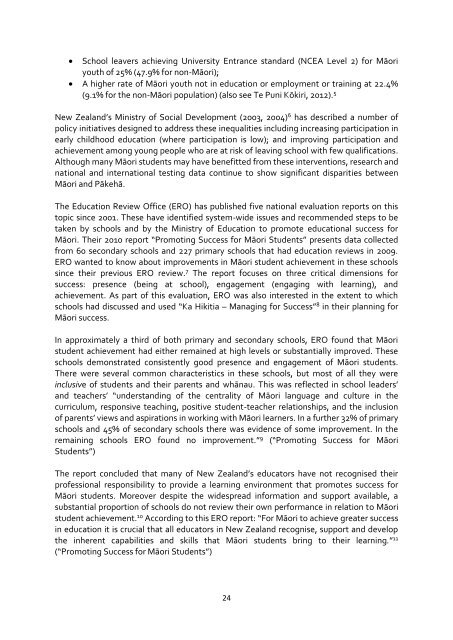UNCONSCIOUS BIAS AND EDUCATION
unconsious-bias-and-education
unconsious-bias-and-education
Create successful ePaper yourself
Turn your PDF publications into a flip-book with our unique Google optimized e-Paper software.
School leavers achieving University Entrance standard (NCEA Level 2) for Māori<br />
youth of 25% (47.9% for non-Māori);<br />
A higher rate of Māori youth not in education or employment or training at 22.4%<br />
(9.1% for the non-Māori population) (also see Te Puni Kōkiri, 2012). 5<br />
New Zealand’s Ministry of Social Development (2003, 2004) 6 has described a number of<br />
policy initiatives designed to address these inequalities including increasing participation in<br />
early childhood education (where participation is low); and improving participation and<br />
achievement among young people who are at risk of leaving school with few qualifications.<br />
Although many Māori students may have benefitted from these interventions, research and<br />
national and international testing data continue to show significant disparities between<br />
Māori and Pākehā.<br />
The Education Review Office (ERO) has published five national evaluation reports on this<br />
topic since 2001. These have identified system-wide issues and recommended steps to be<br />
taken by schools and by the Ministry of Education to promote educational success for<br />
Māori. Their 2010 report “Promoting Success for Māori Students” presents data collected<br />
from 60 secondary schools and 227 primary schools that had education reviews in 2009.<br />
ERO wanted to know about improvements in Māori student achievement in these schools<br />
since their previous ERO review. 7 The report focuses on three critical dimensions for<br />
success: presence (being at school), engagement (engaging with learning), and<br />
achievement. As part of this evaluation, ERO was also interested in the extent to which<br />
schools had discussed and used “Ka Hikitia – Managing for Success” 8 in their planning for<br />
Māori success.<br />
In approximately a third of both primary and secondary schools, ERO found that Māori<br />
student achievement had either remained at high levels or substantially improved. These<br />
schools demonstrated consistently good presence and engagement of Māori students.<br />
There were several common characteristics in these schools, but most of all they were<br />
inclusive of students and their parents and whānau. This was reflected in school leaders’<br />
and teachers’ “understanding of the centrality of Māori language and culture in the<br />
curriculum, responsive teaching, positive student-teacher relationships, and the inclusion<br />
of parents’ views and aspirations in working with Māori learners. In a further 32% of primary<br />
schools and 45% of secondary schools there was evidence of some improvement. In the<br />
remaining schools ERO found no improvement.” 9 (“Promoting Success for Māori<br />
Students”)<br />
The report concluded that many of New Zealand’s educators have not recognised their<br />
professional responsibility to provide a learning environment that promotes success for<br />
Māori students. Moreover despite the widespread information and support available, a<br />
substantial proportion of schools do not review their own performance in relation to Māori<br />
student achievement. 10 According to this ERO report: “For Māori to achieve greater success<br />
in education it is crucial that all educators in New Zealand recognise, support and develop<br />
the inherent capabilities and skills that Māori students bring to their learning.” 11<br />
(“Promoting Success for Māori Students”)<br />
24


